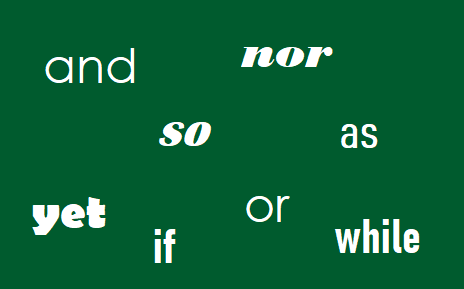Conjunctions are the ‘joining words’ of a language. A sentence is broken up into parts and joined together as a whole by using these connecting words of the English language.
Conjunctions help to make a sentence flow smoothly by joining phrases and clauses, showing the relationship between connected ideas.
There are three main types of conjunctions in the English language: coordinating, subordinating and correlative.
Coordinating Conjunctions
Coordinating conjunctions connect two independent clauses. Some common coordinating conjunctions are:
and, but, or, however, while, yet, so.
Sometimes we split coordinating conjunctions into four types:
- Cumulative conjunctions – used to add two ideas together (e.g. and, both, as well as)
- Adversative conjunctions – used to contrast two ideas (e.g. but, whereas, nevertheless, still)
- Disjunctive conjunctions – used to present two alternatives (e.g. or, either/or, neither/nor)
- Illative conjunctions – used to express inferences (e.g. for, so)
For example:
The man ate the sandwich, but the bread was dry.
The cat caught a mouse, however, it didn’t harm it and the mouse easily escaped
The children want to go to the park and the zoo at the weekend.
We had already walked for hours, so when arrived we were exhausted
I wasn’t hungry then, for I never ate dinner before seven
In this first example, ‘The man eats the sandwich’ is the first clause in the larger two part sentence. The second clause is ‘the bread was dry’. The conjunction (or connecting word) used here is ‘but’.
In the other examples, the conjunction words connecting the two clauses are underlined.
Subordinating Conjunctions
Subordinating conjunctions are used to connect two clauses when one clause is dependent on the other. Some common subordinating conjunctions are:
because, unless, since, until, that, although, as if/though, as much as.
For example:
The woman was famous because she had written a successful book.
This is the book that I chose for Mary’s present.
The boy watched the film, although he did not enjoy it.
I haven’t played the piano since I broke my wrist
She picked up the bicycle as though it were a feather
- Notice the use of the subjunctive mood in the above sentence.The word ‘were’ is used instead of the usual ‘was’ after the phrase ‘as though’, indicating this is an imaginary situation (the bicycle was not really a feather!)

A bike – not a feather – Image source
In this first example, the clause ‘the woman was famous’ depends on the clause ‘because she had written a successful book’.
In the second example, the second clause ‘I chose for Mary’s present’ is dependent on the first clause ‘this is the book’.
The third example has ‘he did not enjoy it’ dependent on ‘the boy watched the film’.
Correlative Conjunctions
Correlative conjunctions must be used together as a pair. They are used to talk about two related ideas. For example:
either/or, neither/nor, both/and, rather/than, whether/or
Example sentences:
Neither Jacob nor Laura could open the gate without falling over
I want either roast chicken or roast lamb for dinner
She would rather go to Italy than France on holiday this summer
He didn’t know whether to wear the red shirt or the blue one
They decided to study both history and geography in college
In the EFL class, a good way to teach conjunctions is to use example sentences with the words missing. Students should then fill in the blanks with the correct words.
Students could also create their own sentences using their own choice of topics or themes relevant to current news items chosen by the teacher.
Share your thoughts on English conjunctions
Do you have any questions or thoughts on English conjunctions?
Which conjunctions do you find the most difficult to use?
Do you have other good examples of these words in context?
Teachers, how do you like to teach conjunctions in the EFL class?
Let us know your thoughts in the comments.

